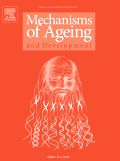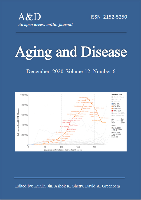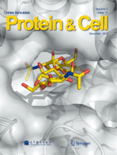
MECHANISMS OF AGEING AND DEVELOPMENT
Scope & Guideline
Decoding the Secrets of Life's Progression
Introduction
Aims and Scopes
- Cellular Senescence and Aging Mechanisms:
The journal extensively covers research on cellular senescence, its role in aging, and its implications for age-related diseases. It investigates the molecular pathways involved in senescence, including the senescence-associated secretory phenotype (SASP), and how these processes affect tissue function and regeneration. - Biomarkers of Aging:
A core area of focus is the identification and validation of biomarkers associated with aging and age-related diseases. This includes the exploration of genetic, epigenetic, and metabolic markers that can predict biological age and health outcomes. - Therapeutic Interventions:
Research on therapeutic strategies to mitigate aging effects, including pharmacological agents (like senolytics and geroprotectors), dietary restrictions, and lifestyle interventions, is a significant aspect of the journal's scope. These studies aim to translate basic research into clinical applications. - Age-Related Diseases:
The journal addresses various diseases associated with aging, such as neurodegenerative disorders, cardiovascular diseases, and metabolic syndromes. It emphasizes understanding the pathophysiology of these conditions and their interrelations with aging processes. - Interdisciplinary Research:
The journal promotes interdisciplinary studies that integrate insights from genetics, molecular biology, biochemistry, and clinical research to provide a comprehensive understanding of aging and its impact on health.
Trending and Emerging
- Senolytics and Senotherapeutics:
There is a notable increase in research focused on senolytic drugs and therapies aimed at selectively eliminating senescent cells to improve healthspan. This trend underscores the potential therapeutic strategies to combat aging-related diseases. - Inflammaging and Immune Response:
Emerging studies are increasingly exploring the concept of 'inflammaging', the chronic low-grade inflammation associated with aging, and its role in various diseases. This theme is critical for understanding the intersection of aging and the immune system. - Microbiome and Aging Interactions:
Research is trending towards understanding how gut microbiota influence aging processes and age-related diseases. The gut-brain axis and its implications for cognitive decline and metabolic health are gaining significant attention. - Personalized Aging Interventions:
There is a growing focus on personalized approaches to aging interventions, including tailored dietary and pharmacological strategies based on individual genetic and metabolic profiles. This trend aligns with advancements in precision medicine. - Interdisciplinary Approaches:
An increasing number of studies are utilizing interdisciplinary methodologies, combining insights from genetics, epigenetics, and systems biology to create a more holistic understanding of aging and its associated diseases.
Declining or Waning
- Basic Mechanistic Studies in Non-Mammalian Models:
Research utilizing non-mammalian models (like yeast and nematodes) for basic mechanistic studies of aging has seen a decrease. While these models provided valuable insights, there is now a stronger emphasis on mammalian systems that are more directly translatable to human health. - Traditional Models of Aging:
There has been a waning interest in traditional aging models that do not incorporate modern techniques such as genomics and proteomics. Studies that rely solely on classical methods without integrating advanced technologies are less frequent. - Focus on Single Biomarkers:
Research focusing on single biomarkers of aging is diminishing in favor of more comprehensive biomarker panels and systems biology approaches. The complexity of aging necessitates a broader perspective that considers multiple interacting factors. - Aging and Gender Studies:
Although still relevant, studies specifically addressing gender differences in aging are less frequent compared to the increasing emphasis on gender-neutral approaches that consider a wide range of biological and environmental factors.
Similar Journals

JOURNALS OF GERONTOLOGY SERIES A-BIOLOGICAL SCIENCES AND MEDICAL SCIENCES
Transforming Aging Research into Practical SolutionsJournals of Gerontology Series A: Biological Sciences and Medical Sciences, published by Oxford University Press Inc, stands at the forefront of aging research, bridging the gap between biological sciences and medical practices to address the complexities of gerontology. With an impressive impact factor reflecting its significant contribution to the field, this journal is recognized within the Q2 quartile in Aging and the Q1 quartile in Geriatrics and Gerontology for 2023, evidencing its high-quality scholarship and relevance. Researchers and professionals will find valuable insights through its comprehensive coverage of aging-related topics, informed by cutting-edge studies ranked among the top in their category—Rank #11 in Geriatrics and Gerontology and Rank #9 in Aging on Scopus. The journal aims to disseminate innovative research that can impact health care practices and enhance the quality of life in older populations. For those engaged in studies of aging, this journal offers a vital platform for sharing knowledge and advancing the understanding of biological and medical sciences as they pertain to gerontology.

Frontiers in Aging
Advancing the Science of AgingFrontiers in Aging is a leading academic journal published by FRONTIERS MEDIA SA, dedicated to advancing the understanding of the biological processes associated with aging. Established in 2020, this open-access journal aims to bridge the gap between various disciplines including genetics, molecular biology, and physiology, providing a multidisciplinary platform for researchers and clinicians alike. With a notable impact factor denoted by its Q2 quartile rankings in Aging, Genetics, and Molecular Biology, and a Q1 ranking in Physiology as of 2023, the journal is recognized for its contribution to the scientific community. Located in Lausanne, Switzerland, it is committed to promoting open discourse and publishing cutting-edge studies that address the complexities of aging and its implications for health and longevity. The journal’s editorial board, consisting of leading experts, ensures the rigorous peer-review process, maintaining high academic standards and fostering innovation in aging research.

BIOGERONTOLOGY
Illuminating the Path to Healthy AgingBIOGERONTOLOGY, published by SPRINGER, is a premier journal dedicated to the interdisciplinary study of biological aging processes and their implications for health and longevity. With an ISSN of 1389-5729 and an E-ISSN of 1573-6768, this journal features cutting-edge research that addresses critical questions in the fields of aging, geriatrics, and gerontology. Ranking impressively in the top quartiles, particularly as Q1 in Gerontology, BIOGERONTOLOGY is recognized for its contributions to advancing the understanding of aging at both molecular and systemic levels. The journal’s rich repository of scholarly articles provides valuable insights for researchers, healthcare professionals, and students alike, fostering a deeper comprehension of age-related biological mechanisms. Although not an open-access journal, it is highly regarded with an impact factor that reflects its significant role in the academic community. The journal spans from 2000 to 2024, ensuring a broad historical context for its studies, and is based in the Netherlands, with its administrative office located at One New York Plaza, Suite 4600, New York, NY 10004, United States. Engaging with BIOGERONTOLOGY means joining a global dialogue on the science of aging and the implications it holds for humanity.

Aging-US
Fostering Innovation in Aging ScienceAging-US is a premier peer-reviewed journal dedicated to advancing the field of aging research and cell biology. Published by IMPACT JOURNALS LLC, this journal serves as a vital resource for researchers and professionals exploring the biological mechanisms of aging and their implications for health and disease. With a commendable impact factor reflected in its 2023 Scopus rankings, where it stands at Rank #10/38 in the category of Aging and Rank #63/285 in Cell Biology, Aging-US exemplifies rigorous scientific excellence. Its open access policy enhances accessibility, fostering a wider dissemination of knowledge in both academic and clinical settings. Spanning from 2009 to 2024, the journal provides a platform for groundbreaking studies and innovative methodologies, ensuring that it remains at the forefront of the dynamic conversations surrounding aging and cellular biology. Engage with Aging-US to contribute to the evolving narratives of longevity and cellular health.

Aging Brain
Illuminating the Path to Cognitive LongevityAging Brain is a premier Open Access journal published by Elsevier, dedicated to advancing the understanding of the neurobiological changes associated with aging. Since its commencement in 2021, this journal has been pivotal in disseminating high-quality research that explores the intricate relationships between aging and cognitive functions, neurological disorders, and overall brain health. With a notable commitment to open accessibility, Aging Brain ensures that vital findings are available to a global audience, fostering collaboration and innovation in the field. Researchers, healthcare professionals, and students alike will find a rich repository of cutting-edge studies, reviews, and insights aimed at addressing the complexities of the aging brain. The journal stands as an influential platform for those passionate about enhancing the quality of life for the aging population, making it a valuable resource in gerontology and neuroscience.

Physiological Reviews
Fostering Excellence in Physiological Research and AnalysisPhysiological Reviews is a prestigious journal published by the American Physiological Society, dedicated to advancing our understanding of physiology across various domains. With an impressive impact factor that places it in Q1 quartiles for medicine, molecular biology, and physiology as of 2023, this journal is recognized as a leading source of high-quality reviews and research analyses. The journal has been a vital resource for the scientific community since its inception in 1945, providing in-depth and comprehensive insights that are crucial for both scholars and practitioners in the field. Although not an open-access publication, it remains widely accessible through institutional subscriptions, ensuring that crucial research findings are disseminated efficiently. With Scopus rankings that place it in the top percentile across multiple categories, Physiological Reviews continues to be an essential platform for the latest advancements and discoveries in physiology, making it indispensable for researchers, professionals, and students alike.

Neuropeptides
Exploring the Intricacies of NeuropeptidesNeuropeptides is a prestigious, peer-reviewed journal published by Elsevier, focusing on the critical role of neuropeptides in various biological processes and their implications in cellular and molecular neuroscience, endocrinology, and neurology. With an impact factor reflecting its influence in the field and a diverse audience ranging from researchers to healthcare professionals, the journal serves as an essential platform for the dissemination of groundbreaking research from 1980 to 2024. Adhering to high academic standards, Neuropeptides holds a Q3 ranking in Cellular and Molecular Neuroscience and Endocrine and Autonomic Systems, alongside a solid Q2 ranking in both Endocrinology and Neurology. This positions the journal at the forefront of its disciplines, contributing valuable insights into the understanding of neuropeptide functions in health and disease. By not operating as an Open Access journal, it ensures sustainability in the publishing process while upholding rigorous review standards. Researchers, professionals, and students are encouraged to engage with the findings published in this journal, which plays a vital role in advancing knowledge and fostering collaboration within the neuroscientific community.

Aging and Disease
Illuminating pathways to better health in aging.Aging and Disease is a leading open-access journal published by the International Society on Aging and Disease, dedicated to advancing the understanding of aging and its associated diseases. Since its inception in 2010, the journal has established itself as a vital resource for researchers and practitioners in the fields of Geriatrics, Neurology, Cell Biology, and Pathology. With an impressive Q1 ranking across multiple categories and a robust position in Scopus rankings, including ranks in the top 3% in Geriatrics and Gerontology, it showcases high-quality research that addresses the complexities of aging processes. Each issue presents original articles, reviews, and insights aimed at improving health outcomes for the aging population. The open-access model ensures that valuable research findings are readily available to a global audience, fostering collaboration and innovation. As a go-to publication for scholars, healthcare professionals, and students, Aging and Disease significantly contributes to the multidisciplinary dialogue surrounding aging and its health implications.

npj Aging and Mechanisms of Disease
Advancing Knowledge in Aging and Geriatric Sciencenpj Aging and Mechanisms of Disease is a leading open-access journal dedicated to advancing the understanding of the biological mechanisms underlying aging and age-related diseases. Published by NATURE PORTFOLIO in the United Kingdom, this journal has established itself as a vital resource within the fields of Aging and Geriatrics and Gerontology, proudly holding a prestigious Q1 ranking in both categories as of 2023. With an impressive Scopus ranking, placing it in the top 10 for Geriatrics and Gerontology, and the top 9 for Aging, the journal is committed to disseminating high-quality, peer-reviewed research that offers innovative insights and fosters collaboration among researchers and practitioners. Since its inception in 2015, npj Aging and Mechanisms of Disease has embraced the open-access model, ensuring that groundbreaking findings are freely available to all, thereby promoting widespread knowledge-sharing within the scientific community. This journal serves as an essential platform for those seeking to explore the complex interplay of genetic, molecular, and environmental factors that influence aging and its associated challenges.

Protein & Cell
Exploring the Frontiers of Protein and Cell ResearchProtein & Cell, published by Oxford University Press, is a distinguished international journal focusing on cutting-edge research in the fields of biochemistry, biotechnology, cell biology, and drug discovery. This open access journal, active since 2014, is dedicated to disseminating innovative findings that advance our understanding of protein functions and cellular processes, making it an essential resource for researchers, professionals, and students alike. With an impressive 2023 impact factor reflected in its Q1 ranking across multiple categories such as Biochemistry, Drug Discovery, and Cell Biology, 'Protein & Cell' stands at the forefront of scientific research, driving collaboration and discussion in the scientific community. Researchers can access the journal freely online, fostering a global exchange of knowledge and contributing to significant advancements in medicine and biotechnology. Located in the United Kingdom, the journal strives to be a pivotal platform for impactful research that influences future studies and applications.